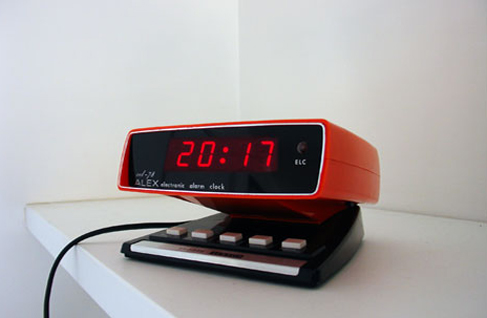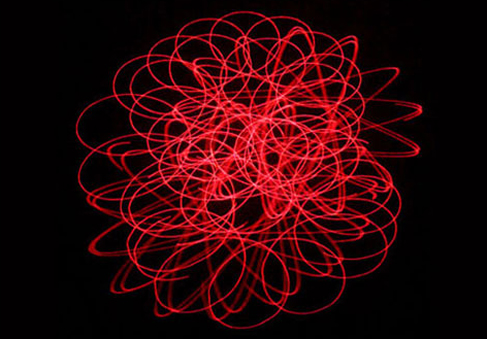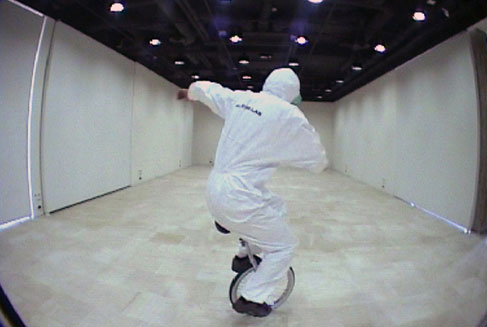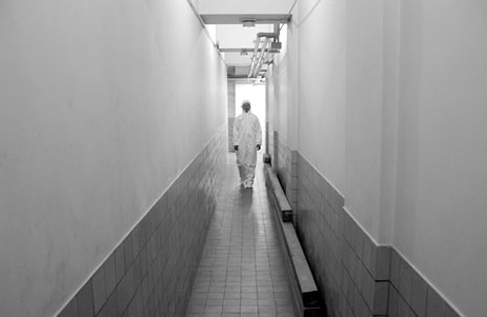|

DAVIDE BERTOCCHI
MONO-CYCLES
02.04 / 15.07.2011
By choosing 'Mono-Cycles' as the title of your solo show you decided to establish a direct relation to the art pieces that are part of the exhibition and at the same time to a vision of science (and subsequently technology) free from any notion of evolution.
Every work has been coinceived as a cycle, an autonomous epistemological system, and I find the idea of ‘mono’ and in general the definiton of ‘unambiguous’ relevant to define a recurring scientific behaviour.
From the beginning of the scientific history there always has been a sequence of ‘models’ and consequently a lot of efforts were made to answer fundamental questions regarding the origin of the universe or to interpret the reality that surround us. A scientific monopoly that assumed the presumption of explaining everything. Infinite hypotheses and answers, but the real Answer remains unknown. Personally, I’m fascinated by this reticence in admitting that maybe the only Truth is that the man has not been programmed to know it and that maybe he will never know. The immensity of what we don’t know – whether we can accept it or not - remains our biggest freedom.
A freedom that looks in danger in the laboratory sequences of 'Nice-Time-Lab' and in the premises connected to the release of another video that is part of exhibition, 'The Building'. In which way these two projects were born? Are they connected?
As you can see there are elements taken from the iconography of science in both projects, like white suits and a certain aestethics that tries to simulate a scientific language. The premises of these two works are quite far away from each other.
'Nice-Time-Lab' is the one more connected to the concept of an experiment. It is a series of empirical attempts to ride a monocycle. An activity without a particular practical or economical function. A senseless movement that nonetheless carries philophical or existential implications. In every sequence I'm trying to ride this monocycle but every attempt ends with a failure... if we think that the goal is to ride it. My goal was just the attempt of riding it, including the chance of a failure, using up time with an action with no functionality, as we are used to when we are on holidays. It is a work about time conceived during a residency in Nice (Villa Arson) where the most estranged element of the city it was this dilated concept of time.
'The Building' was born from an intimate reaction to a special place, one of the three buildings that survived that atomic bomb in Hiroshima. This place is the Bank of Japan, a building used after the explosion as mortuary and refuge. When I entered the building for the first time I felt something strange, as if the building were still inhabited by presences from the past. Everything was as at the time of the explosion, even the clocks. I felt the urgence to use the corridor that surrounds the central strongbox, the most uncanny place of the entire building. At every corner of this corridor it is possible to find mirrors which were used to have a complete view of the space. A sort of surveillance system ante litteram.
The main character (a hybrid entity in between a researcher and a ghost) walks through the corridor and the video camera follows him showing his reflections in the mirrors: the video camera then stops on his mirrored image that continues to walk before disappearing inside one of the mirrors.
Maybe something that connects these two videos is a certain nonsense in the action....
One of the ways in which you usually create art objects is a complete overturning of their original function. Your free use of laser beams in 'Orbite' it is a clear example: an installation where chaos became the prevalent side of the work starting from an object thas has in its precision its distinctive feature.
I have always been interested in geometrical and mathematical models, in their precision and their apparently 'sublime' perfection. In this work the project started from an experiment as well: the overlapping of six of these laser beams that, individually, are able to create superficially perfect figures. The result of this action is a more complex structure that is quite similar to a chaotic form. It is indeed clear for me that chaos is a so complex and precise structure that its understanding and even a complete overview of it is impossible. An evolved form of order that is totally unknown to us.
'Tropicalnocturnalpastiche' stresses the relation between fascination and fear, synthesising in a paradox a possible, terrible, use of one of the most relevant scientific researches of the last century.
Yes, it is a work composed of 25 images of atomic tests carried out in 'tropical paradises', from the Bikini Islands to Muroroa. Besides the absurdity of the tests in general (more than 2000 - ! - from 1945 to today) it is possible to see in these images a clear dystopic trend in science, especially if you consider the places chosen for the tests. I was also interested by the idea of this terrible beauty, diabolic and almost romantic, that every image has in itself, considering the nuclear explosion as a semi divine expression. A proof that the fundamental principles of the universe have been dominated and reproduced by man... but in a clumsy, worrying, wicked way.
In 'Passato, Futuro' your project subverts not only the use of an alarm clock from the 70s, but also the notion of 'present time'. A 'time' that naturally dissolves itself in a random sequence of different times. The key of this work is in its title. Because of a small correction in its electronic circuits, the time of this clock changes in a sudden, unpredictable, way: the chance of showing the current time (the present time) is impossible. It is always before or after, but it is almost never present. I wanted to discuss our obsession for synchronization looking at our perception of time in an absolute space. I'm not acting on 'Time' (still not... unfortunately!), but on our perception of it through the numbers of an old clock. It is also possible to see this project in another way, more connected with the object: an orange clock from the 70s inevitably reminds of the famous film 'A Clockwork Orange' by Stanley Kubrick, released in 1972. Even the name of the clock is 'Alex' like the film's main character. All these things are completely accidental. This work is in a certain way an apology to random...


Biography
Born 1969 in Modena (IT).
Lives and works in Paris (FR).
Website: www.davidebertocchi.com


On Screening:
Nice Time Lab (dvd, 8'15'', 2003)
The Building (dvd, 2'28'', 2004)
Selected Films:
Once upon a time in the West (Sergio Leone 1968)
THX 1138 (George Lucas 1971)
An Orange Clockwork (Stanley Kubrick 1972)
---
Curated by Marco Nember.
Developed in collaboration with
the Italian Institute of Culture in
Amsterdam between May 2009
and September 2013.
|